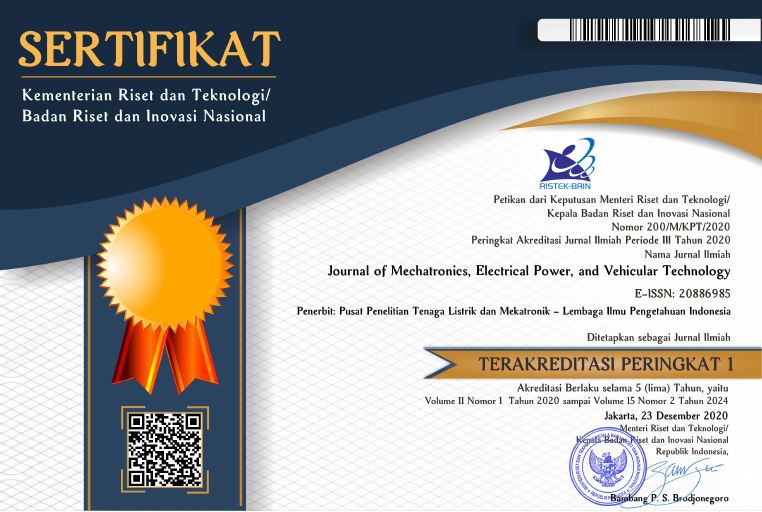Modeling and design of cooperative braking in electric and hybrid vehicles using induction machine and hydraulic brake
Abstract
Full Text:
PDFReferences
Zaini Dalimus, “Braking System Modeling and Brake Temperature Response to Repeated Cycle,” Journal of Mechatronics, Electrical Power, and Vehicular Technology, 2014, vol. 05, pp.123-128. Crossref
Chau, K. T., Chan, C. C., Liu, C.: “Overview of permanent-magnet brushless drives for electric and hybrid electric vehicles,” IEEE Transactions on Industrial Electronics, 2008, 55, (6), pp. 2246-2257. Crossref
Dorrell, D.G., Knight, A.M.,Popescu, M., Evans, L., Staton, D.A.: “Comparison of different motor design drives for hybrid electric vehicles,” Energy Conversion Congress and Exposition, 2010, pp. 3352 – 3359. Crossref
Khoucha, F., Marouani, K., Haddoun, A., Kheloui, A. and Benbouzid, M.E.H. : “Improved Sensorless DTC Scheme for EV Induction Motors,” 2007 IEEE International Electric Machines & Drives Conference, Antalya, 2007, pp. 1159-1164. Crossref
Vyncke, T. J., Boel R. K.,Melkebeek, J. A. A.: “Direct torque control of permanent magnet synchronous motors – an overview,”
rd IEEE Benelux Young Researchers Symposium in Electrical Power Engineering, Ghent, Belgium, 2006, pp. 1-5. Crossref
Ohtani, Y., Innami, T., Obata, T., Yamaguchi, T., Kimura, T. and Oshima, T.: “Development of an Electrically-Driven Intelligent Brake Unit,” SAE Techical Paper, 2011-01-0572. 2007. Crossref
Yuan, D., Wei, J., Qu, Y., and Wu, J. : “Simulation of hydraulic brake built-in test system for a certain UAV,” Control Conference (CCC), 2013 32nd Chinese, Xi'an, 2013, pp. 801-804.
Park, M., Kim, S.,Yang, L., Kim, K.: “Development of the control logic of electronically controlled hydraulic brake system for hybrid vehicle,” SAE Technical Paper 2009-01-1215, 2009, pp. 1-7. Crossref
Aoki, Y., Suzuki, K., Nakano, H., Akamine, K.: “Development of hydraulic servo brake systemfor cooperative control with regenerative brake,” SAE Technical Paper 2007-01-0868, 2007, pp. 1-9. Crossref
Albrichsfeld, C. V., Karner, J.: “Brake system for hybrid and electric vehicles,” SAE Technical Paper 2009-01-1217, 2009, pp. 1-7. Crossref
Lei, Z., Yugong, L., Diange, Y., Keqiang, L., and Xiaomin, L., “A novel brake control strategy for electric vehicles based on slip trial method,” Vehicular Electronics and Safety, 2007. ICVES. IEEE International Conference on, Beijing, 2007, pp. 1-6. Crossref
Tremblay, O., Dessaint, L. A.: “Experimental validation of a battery dynamic model for EV applications,” World Electric Vehicle Journal, 2009, 3, pp. 1-10
Ghorbani, M. J., Akhbari, M. and Mokhtari, H. : “Direct torque control of induction motor by Active Learning Method,” Power Electronic & Drive Systems & Technologies Conference (PEDSTC), 2010 1st, Tehran, Iran, 2010, pp. 267-272. Crossref
Qi, X., Song, J., Wang, H.: “Influence of hydraulic ABS parameters on solenoid valve dynamic response and braking effect,” SAE Technical Paper 2005-01-1590, 2005, pp. 1-12. Crossref
Zaini, Z., Hussain, K., Day, A. J.: “Mixed-mode braking system for road vehicles with regenerative braking,” 6th European Conference on Braking, Lille, France, 2010, pp. 115-122.
Article Metrics
Metrics powered by PLOS ALM
Refbacks
- There are currently no refbacks.
Copyright (c) 2016 Journal of Mechatronics, Electrical Power, and Vehicular Technology

This work is licensed under a Creative Commons Attribution-NonCommercial-ShareAlike 4.0 International License.




















